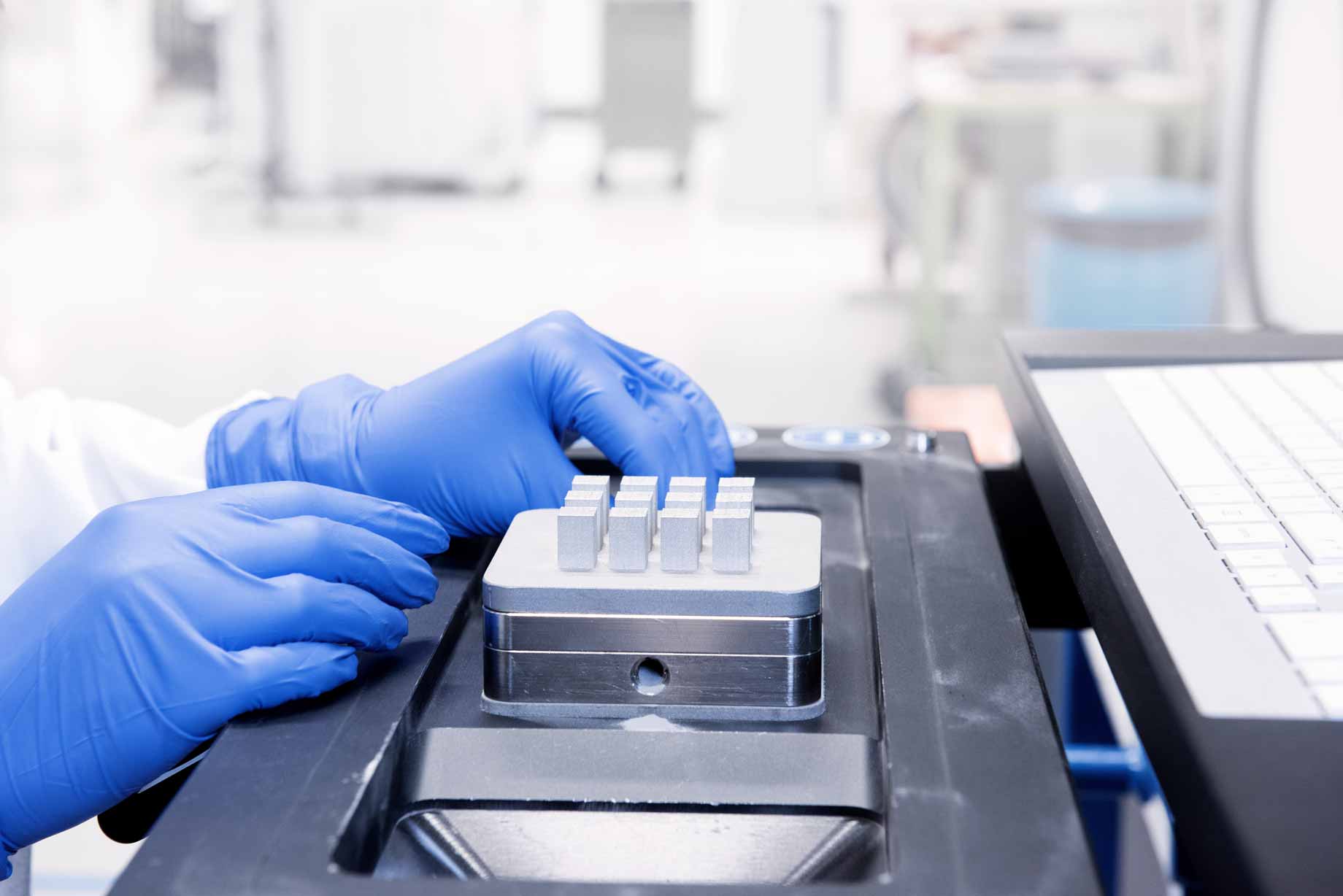BY CANDICE MAJEWSKI
We’ve seen some surprises along the way, with the closure of Renishaw’s North Staffordshire site, Metalysis going into administration before being taken over by Power Resources Group and voxeljet’s decision to close its UK facility.
There remain clear indications of UK growth and sustained excellence. Cookson Gold is strengthening its reputation in AM-related systems with the launch of the ATO Noble precious metal powder production system (in collaboration with Polish company 3D Lab), and Renishaw announced a new collaboration with Sandvik for qualification of metals and alloys. Photocentric’s LC Precision 1.5 system won the 3D Printing Industry ‘Best Personal Printer of the Year’ award, Protolabs have been awarded the Queen’s Award for International Trade, and Jaguar Landrover launched their first production car including multiple AM parts. Chris Noble says ‘the Jaguar XE SV Project 8, limited to just 300 examples worldwide, was an ideal vehicle for AM. Leveraging the benefits of 3D printing eliminated tooling costs for many parts, whilst simultaneously allowing for unique features on the vehicle to deliver maximum performance. We were proud for the AM work on Project 8 to be recognised recently by the Society of Plastic Engineers at their Innovation Awards, and look forward to furthering our activity across prototyping, manufacturing and production part applications.
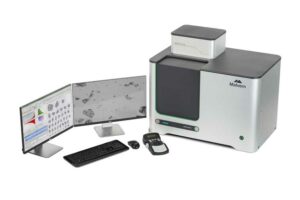
Malvern Panalytical Morphologi 4 particle characterisation system.
London-based AMFG, producers of workflow automation software for AM, have announced partnerships with EOS GmbH and Autodesk, highlighting the increasing importance placed on more connected process chains, and with improved repeatability becoming key characterisation has become increasingly important. Freeman Technology say this year has seen significant growth in installations of their FT4 powder flow systems into manufacturing organisations typically focused on more traditional techniques, and Malvern Panalytical see increasing use of their imaging and chemical characterisation systems for analysis of powders, including understanding effects of processing and storage.
Post-processing remains prominent,with Dyemansion launching its newPowerfuse S system, offering ‘fullyautomatic loading, connectivity andbatch tracking features’ to allow integrationwith the company’s Print-to-Productworkflow. Sheffield-based AdditiveManufacturing Technologies (AMT) Ltdrecently unveiled their integrated DigitalManufacturing System (DMS), incorporatingunpacking and de-powderingthrough to part finishing and inspection,and has recently raised £4.2 million fromDSM Venturing and the ForesightWilliams Technology EIS Fund, to help toaccelerate their global growth.
CEO Joseph Crabtree says ‘the importance of the funding round goes well beyond the financial implications for us. Equally valuable is the collaborative expertise of our funding partners for materials (DSM) and engineering application development (Williams) which will support our drive towards providing truly sustainable, digitally connected and fully automated post processing workflows for additive manufacturing.’
The UK has a proud tradition of AM research and of investment in people, and this shows no signs of abating. Approximately 10% of UKRI-funded proposals starting from 2007 and featuring some element of AM, have starting dates on or after January 2019.
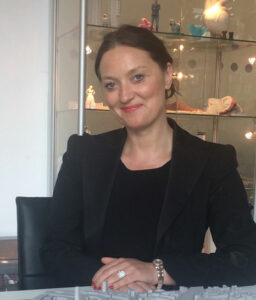
Kadine James – Hobs 3D’s Creative Tech Lead
We can also see investment in collaboration and support for industry; the Centre for Process Innovation recently announced £2.3 million to support SMEs in the North East to develop new products and processes using AM technologies, and the Knowledge Transfer Network AM Special Interest Group continues to host information-exchange and networking events.
Women in 3D Printing (https://womenin3dprinting. com/) is a global initiative promoting and supporting women using AM; its UK chapter has 500+ members across multiple sectors and aims to facilitate connections and collaborations, keep a spotlight on UK AM and to support an ongoing pipeline of talent through working with schools to promote STEM and 3D Printing. Hobs 3D’s creative tech lead Kadine James says ‘Our community continues to grow across the UK and it’s so inspiring to be a part of this worldwide platform that supports the diversity and digital skills agenda by creating more opportunities to bring female talent into our industry. Diverse teams allow organizations to provide environments that cultivate more creativity and new ways of thinking this allows for more innovation and productivity and with no sign of the AM industry slowing down it’s becoming increasingly important to deliver change and commit to a bigger vision that diversity and inclusion produce better results.’
A bionic future?
Not so long ago, much of the talk about medical AM seemed like something we’d be more likely to see in a science fiction movie, but we’ve seen great strides in this area – everything from production of complex surgical guides through to printing of human organs. Georgi Makin, Senior Editor of 3DMedNet, comments that ‘from speaking to many people at 3DMedLIVE and working with the wider community with 3DMedNet, it is clear that AM is already making an impact in the medical space. As the demand for personalized care increases, AM finds a niche in the development of practical, customizable solutions in many areas of medicine.’
AM has become well-established as a method of surgical planning; a highlight of this year was a 100-strong team at Great Ormond Street successfully separating conjoined twins Safa and Marwa, joined at the head, over a period of four months. A combination of Virtual Reality and AM was used to determine and practice the most appropriate surgical strategy.
New developments keep coming in AM orthotics and prosthetics. The IMPACT project, led by Iterate Design and Innovation Ltd, incorporates the use of embedded electrical circuitry to produce a personalised ‘bionic hand’ with articulated thumb and Londonbased Andiamo have recently launched their clinic offering custom 3D Printed orthoses mainly for children with disabilities.
Renishaw’s manufacture of a device for the North Bristol NHS Trust to aid long-term drug infusion for patients with Parkinson’s disease was a clear highlight this year. The titanium AM device, which won the TCT Healthcare Application Award, is embedded in a patient’s skull to enable delivery of the relevant drug directly to the brain and is expected to have potential for use in other brain-related disorders.
Looking forward we can expect to see many other applications becoming more commonplace in a hospital setting – for example 3D printers to produce accurate implants for or to print skin grafts directly into wounds. And of course, while it may still be a long time before we’re routinely implanting Additive Manufactured organs, this remains on the horizon. There can be no doubt that AM will continue to have increasing impact in the medical arena, so watch this space…

Jaguar XE SV Project 8
Credit: JaguarLandRover
As 2019 draws to a close there is no doubt change is in the air. Xerox appear serious in their attempts to merge with or take over HP, with clear implications for their AM activities. GKN Powder Metallurgy expanded into polymers with their takeover of FORECAST 3D, UK OEM Gardner Aerospace increased their portfolio by acquiring Lancashire company FDM Digital Solutions, and Stratasys has increased its investment in Xaar 3D to 45% with the possibility of full acquisition.
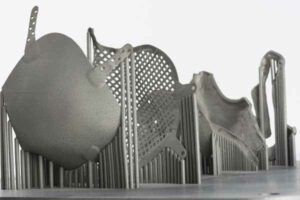
Medical implants additive manufactured by Renishaw
‘One of the greatest achievements of 3DMedLive 2019 was to create a programme which brought together a diverse group of people who wouldn’t normally have the chance to interact with one another. Talks included clinical case studies, practical considerations of running 3D printing hubs in (or associated with) hospitals, the latest on medical device regulations, and ongoing research in pre-clinical trials. The takeaway message was focused on communication between professions, highlighting the considerations surrounding the use of 3D printing, while at the same time showcasing what is technically possible.’
James Wingham, Doctoral Researcher, University of Sheffield

ERIN WALSH, DOCTORAL RESEARCHER, THE UNIVERSITY OF STRATHCLYDE
Erin’s project aims to develop a workflow to produce pharmaceutical products with complex geometries that control the drug release. The technique couples stereolithography (SLA) with hot-melt extrusion (HME) and injection-moulding (IM). Moulds are produced using SLA, allowing for highly complex and detailed structures at a reduced cost and lead-time. HME allows freedom to formulate polymers with drugs and other excipients and is used to prepare the material for injection. IM is then used to form the HME material into the geometry of the printed moulds. The coupling of these techniques is used to produce tablet geometries impossible through traditional means.
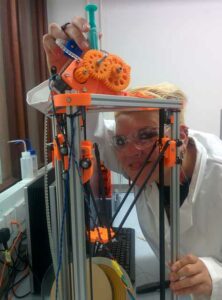
DR KATE OLIVER (WWW.SCHRODINGERSKITTEN.CO.UK)
The more materials that can be printed, the more useful 3D printing is; but new materials need new techniques. Funded by EPSRC, via the Bristol Centre for Functional Nanomaterials, Kate’s PhD focused on developing opensource, inexpensive 3D printing technology, in parallel with printable smart materials. The result was an extrusion printer, optimised to process alginate-based hydrogel into shapes that change with temperature. Immersed in water, these soft, jelly-like materials curl, unroll and shrink when heated, and could be useful as synthetic tissues, soft robotics or valves. Printer plans are available freely for others to build on or replicate.

